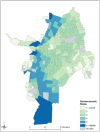Space-Time Conditional Autoregressive Modeling to Estimate Neighborhood-Level Risks for Dengue Fever in Cali, Colombia
- PMID: 32876013
- PMCID: PMC7646775
- DOI: 10.4269/ajtmh.20-0080
Space-Time Conditional Autoregressive Modeling to Estimate Neighborhood-Level Risks for Dengue Fever in Cali, Colombia
Abstract
Vector-borne diseases affect more than 1 billion people a year worldwide, causing more than 1 million deaths, and cost hundreds of billions of dollars in societal costs. Mosquitoes are the most common vectors responsible for transmitting a variety of arboviruses. Dengue fever (DENF) has been responsible for nearly 400 million infections annually. Dengue fever is primarily transmitted by female Aedes aegypti and Aedes albopictus mosquitoes. Because both Aedes species are peri-domestic and container-breeding mosquitoes, dengue surveillance should begin at the local level-where a variety of local factors may increase the risk of transmission. Dengue has been endemic in Colombia for decades and is notably hyperendemic in the city of Cali. For this study, we use weekly cases of DENF in Cali, Colombia, from 2015 to 2016 and develop space-time conditional autoregressive models to quantify how DENF risk is influenced by socioeconomic, environmental, and accessibility risk factors, and lagged weather variables. Our models identify high-risk neighborhoods for DENF throughout Cali. Statistical inference is drawn under Bayesian paradigm using Markov chain Monte Carlo techniques. The results provide detailed insight about the spatial heterogeneity of DENF risk and the associated risk factors (such as weather, proximity to Aedes habitats, and socioeconomic classification) at a fine level, informing public health officials to motivate at-risk neighborhoods to take an active role in vector surveillance and control, and improving educational and surveillance resources throughout the city of Cali.
Figures



Similar articles
-
Knowledge, attitudes, and practices regarding dengue, chikungunya, and Zika in Cali, Colombia.Health Place. 2020 May;63:102339. doi: 10.1016/j.healthplace.2020.102339. Epub 2020 Apr 21. Health Place. 2020. PMID: 32543427
-
Aedes albopictus (Skuse, 1894) infected with the American-Asian genotype of dengue type 2 virus in Medellín suggests its possible role as vector of dengue fever in Colombia.Biomedica. 2017 Mar 29;37(0):135-142. doi: 10.7705/biomedica.v37i0.3474. Biomedica. 2017. PMID: 29161485
-
Space-time clusters and co-occurrence of chikungunya and dengue fever in Colombia from 2015 to 2016.Acta Trop. 2018 Sep;185:77-85. doi: 10.1016/j.actatropica.2018.04.023. Epub 2018 Apr 27. Acta Trop. 2018. PMID: 29709630
-
Critical review of the vector status of Aedes albopictus.Med Vet Entomol. 2004 Sep;18(3):215-27. doi: 10.1111/j.0269-283X.2004.00513.x. Med Vet Entomol. 2004. PMID: 15347388 Review.
-
The Global Expansion of Dengue: How Aedes aegypti Mosquitoes Enabled the First Pandemic Arbovirus.Annu Rev Entomol. 2020 Jan 7;65:191-208. doi: 10.1146/annurev-ento-011019-024918. Epub 2019 Oct 8. Annu Rev Entomol. 2020. PMID: 31594415 Review.
Cited by
-
Effects of climate variability on the spatio-temporal distribution of Dengue in Valle del Cauca, Colombia, from 2001 to 2019.PLoS One. 2024 Oct 8;19(10):e0311607. doi: 10.1371/journal.pone.0311607. eCollection 2024. PLoS One. 2024. PMID: 39378213 Free PMC article.
-
Dengue in Cebu City, Philippines: A Pilot Study of Predictive Models and Visualizations for Public Health.Am J Trop Med Hyg. 2023 Dec 11;110(1):179-187. doi: 10.4269/ajtmh.23-0250. Print 2024 Jan 3. Am J Trop Med Hyg. 2023. PMID: 38081048 Free PMC article.
-
Exploring Dengue Dynamics: A Multi-Scale Analysis of Spatio-Temporal Trends in Ibagué, Colombia.Viruses. 2024 Jun 3;16(6):906. doi: 10.3390/v16060906. Viruses. 2024. PMID: 38932198 Free PMC article.
-
A Systematic Review on Modeling Methods and Influential Factors for Mapping Dengue-Related Risk in Urban Settings.Int J Environ Res Public Health. 2022 Nov 18;19(22):15265. doi: 10.3390/ijerph192215265. Int J Environ Res Public Health. 2022. PMID: 36429980 Free PMC article.
-
Spatio-temporal clusters and patterns of spread of dengue, chikungunya, and Zika in Colombia.PLoS Negl Trop Dis. 2022 Aug 23;16(8):e0010334. doi: 10.1371/journal.pntd.0010334. eCollection 2022 Aug. PLoS Negl Trop Dis. 2022. PMID: 35998165 Free PMC article.
References
-
- World Health Organization , 2014. WHO Factsheet Vector-Borne Diseases. Factsheet No. 387, March 10 Available at: http://www.who.int/kobe_centre/mediacentre/vbdfactsheet.pdf. Accessed December 2, 2019.
-
- Unitaid , 2017. Health Experts Call for New Tools to Tackle Vector-Borne Diseases. Available at: https://unitaid.org/news-blog/health-experts-call-new-tools-tackle-vecto.... Accessed May 13, 2020.
-
- Paupy C, et al. 2010. Comparative role of Aedes albopictus and Aedes aegypti in the emergence of dengue and chikungunya in central Africa. Vector Borne Zoonotic Dis 10: 259–266. - PubMed
Publication types
MeSH terms
LinkOut - more resources
Full Text Sources
Medical

